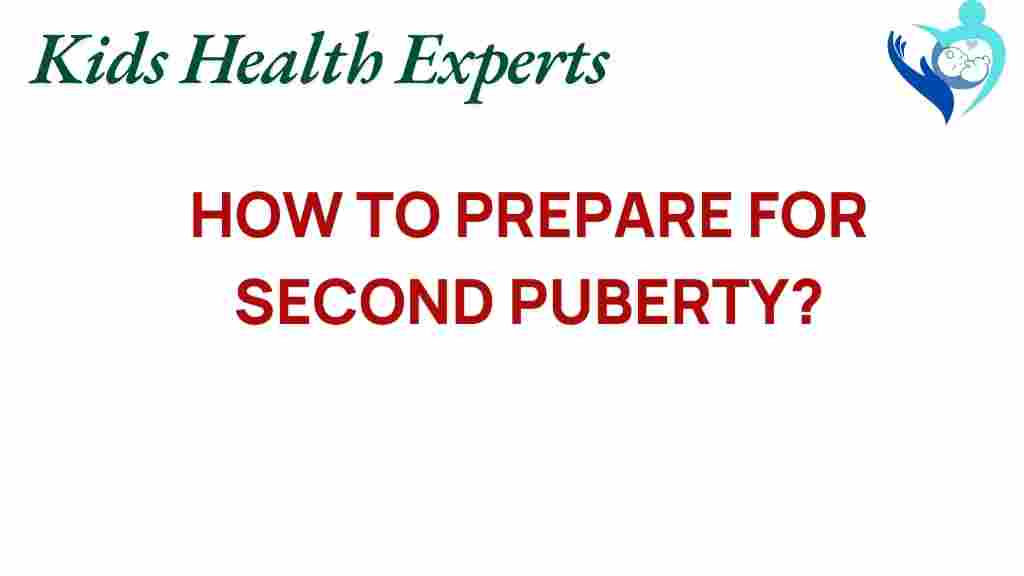As we journey through life, we often encounter various phases of growth and development. One such phase, often overlooked, is what many refer to as “second puberty.” This term describes a time in adulthood when significant hormonal changes, emotional development, and self-discovery occur, akin to the adolescent experience but in a more nuanced way. Understanding these changes is crucial for maintaining mental health, navigating life transitions, and fostering a solid sense of identity and wellness.
What is Second Puberty?
Second puberty typically refers to the hormonal and emotional changes that occur in individuals during their late twenties to early thirties. This period may involve:
- Shifts in hormone levels, including testosterone and estrogen.
- Changes in emotional responses and mental health challenges.
- Increased self-awareness and identity exploration.
This phase can feel like a tumultuous period, similar to the adolescent years, but it is often marked by a deeper understanding of oneself and the world. It’s essential to recognize that these changes are a natural part of human development and can lead to a more profound sense of purpose and well-being.
Understanding Hormonal Changes
During second puberty, individuals may experience fluctuations in hormone levels that can impact various aspects of their lives. Some common hormonal changes include:
- Testosterone Fluctuations: In men, testosterone levels may peak in their late twenties and then gradually decline, which can affect mood, energy, and libido.
- Estrogen Levels: Women may experience changes in estrogen levels due to life events like pregnancy or menopause, impacting their emotional state and physical health.
- Thyroid Hormones: Changes in thyroid function can also affect metabolism, energy levels, and emotional balance.
Understanding these hormonal changes is crucial for managing their effects on mental health and overall wellness.
Emotional Development During Second Puberty
Emotional development is a critical aspect of second puberty. As individuals transition through this phase, they may experience:
- Increased Sensitivity: Heightened emotional responses and sensitivity to stressors can occur as the brain adjusts to new hormonal levels.
- Identity Exploration: This period often sparks a deeper exploration of personal identity, values, and life goals, leading to significant personal growth.
- Relationship Dynamics: Changes in emotional maturity can affect relationships with partners, friends, and family, prompting reevaluation of social connections.
Being aware of these emotional shifts can help individuals navigate their relationships more effectively and foster a supportive environment for self-discovery.
Self-Discovery and Mental Health
Second puberty serves as a catalyst for self-discovery. Individuals may find themselves questioning their life choices, career paths, and personal relationships. This process is vital for mental health and can lead to:
- Increased Self-Awareness: Understanding one’s strengths and weaknesses can enhance decision-making and overall life satisfaction.
- Seeking Help: Individuals may realize the importance of seeking professional help for mental health challenges, such as anxiety or depression.
- Establishing Boundaries: Learning to set emotional and physical boundaries can lead to healthier relationships and improved mental well-being.
Recognizing these aspects of self-discovery can empower individuals to take charge of their mental health and wellness during this transitional phase.
Life Transitions and Identity Formation
Life transitions during second puberty can be significant. These may include:
- Career changes or advancements.
- Shifts in personal relationships, such as marriage or divorce.
- Parenthood or changes in family dynamics.
These transitions can profoundly impact one’s identity. Individuals may find themselves redefining who they are based on new roles and responsibilities. To navigate these changes effectively, consider the following steps:
- Reflect on Your Values: Take time to understand what truly matters to you. Journaling or engaging in meditation can help clarify your values and beliefs.
- Seek Support: Surround yourself with supportive friends and family. Consider joining support groups or seeking therapy to navigate emotional challenges.
- Set Goals: Establish short-term and long-term goals based on your newfound self-awareness and values. This will provide direction during this transitional phase.
- Prioritize Self-Care: Focus on physical and mental wellness through regular exercise, a balanced diet, and mindfulness practices.
- Embrace Change: Accept that change is a part of life. Embrace the uncertainties of this phase as opportunities for growth and learning.
Troubleshooting Tips for Common Challenges
During second puberty, individuals may encounter various challenges. Here are some troubleshooting tips to help manage these obstacles:
- Feeling Overwhelmed: Practice mindfulness and deep breathing exercises. Break tasks into manageable steps to reduce feelings of overwhelm.
- Relationship Struggles: Communicate openly with loved ones about your feelings. Seek couples therapy if necessary to address underlying issues.
- Identity Confusion: Engage in self-exploration activities, such as workshops or retreats, to gain clarity on your identity and life purpose.
- Emotional Instability: Regular exercise and a healthy diet can stabilize mood swings. Consider professional help if emotional challenges persist.
Conclusion: Embracing the Journey of Second Puberty
Navigating the uncharted waters of second puberty can be both challenging and rewarding. By understanding the hormonal changes, emotional development, and life transitions that occur during this phase, individuals can embrace the opportunity for self-discovery and personal growth. It’s essential to prioritize mental health and wellness, seeking support and practicing self-care along the way.
As you embark on this journey, remember that second puberty is a natural part of life. Embrace the changes, learn from the experiences, and allow yourself to grow into the person you are meant to be. For more resources on managing life transitions, consider visiting MentalHealth.gov.
By taking proactive steps and fostering a supportive environment, you can navigate the complexities of second puberty with grace and resilience. Your journey of self-discovery and identity formation is a testament to your strength and capacity for growth.
This article is in the category Mental and created by KidsHealthExperts Team
